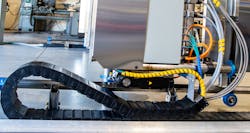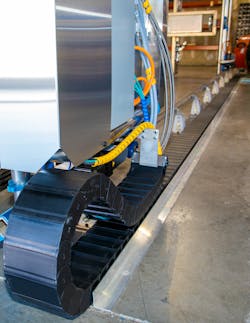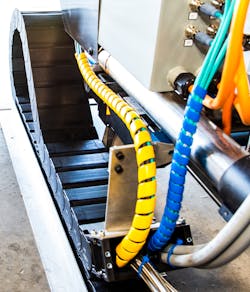Faster Auto Painting is a Cure Thing
While the final product may be incredibly complex, the overarching task in any engineering objective is to design a product that works more efficiently, precisely, faster, and safely. Increased productivity also results in a boost in the bottom line, which is the primary goal of the end-user.
A new advanced automotive paint curing assembly developed by US AutoCure in Phoenix meets all the criteria in the foregoing outline. Its gas-catalytic medium-wave infrared curing system increases throughput while not requiring additional floor space within the shop. The system is the only fully autonomous industrial curing system on the market.
The benefits are astonishing. Owners can complete more repair orders, and increasing output by just one car per day can produce an additional $23,000 per month for body shop owners, according to US AutoCure. That kind of revenue boost is understandable in any language.
“The primary problems solved with this design include increasing throughput of existing paint booths, reducing line defects by reducing the time paint surface is tacky, and removing the paint booth as a bottleneck of the shop while not taking up any additional floor space,” said Mickey Meyer, a managing partner at the company and the lead engineer on the project. “The machines can be installed in existing paint booths and reduce gas and electrical energy use.”
The Curing Process
The painting process for an automobile requires several steps, including stripping, priming, and finally, painting, which can require three or four coats. The paint then needs to cure to make the paint bond together, strengthening the molecules. If the paint does not cure, it is easy to damage the paint job.
Shops used to place cars in giant ovens to cure the paint. The industry has shifted to infrared lamps, which speeds up chemical reactions and drives out solvents. The paint job cures quickly and evenly, and the lamps save energy because heat is applied only to painted panels. This process also reduces the cost of the paint job.
The US AutoCure process takes curing to the next level. The gas-catalytic infrared system results in shorter cure cycles and smaller floor space requirements when compared to conventional paint booths. Designed by engineers and automotive body and paint specialists, the system provides complete vehicles and part coverage.
The fully-digital robotic system does not require precise center alignment of material and is in full compliance with fire codes in the United States and Canada.
“This is the only fully autonomous industrial curing system on the market,” Meyer said. “Similar products are not Class 1 Division 2 certified (a standard established by Underwriters Laboratories for safety in electrical, mechanical, and chemical products). That puts the shop owner at risk of insurance or local fire regulation shut down. The design also meets National Fire Protection Association 79 regulations.”
Dangerous Combination
US AutoCure’s system, The Phoenix, has 13 axes of motion, while another, The Eagle, has 11. With all of the moving parts, heat, dust, chemicals, and gas and electrical lines, the engineering team needed to design a unit that protected lines from pinching and heat sources without limiting the motion of the multiple axes. “Due to the hazardous location environment, any solution needed to meet UL and ISO standards. Each axis required a unique solution,” Meyer said.
igus components throughout both assemblies solved the vexing design issues. The linchpin in the unit is a long-travel energy chain that holds power connections. “As the machine carriage traverses up and down rails within a shop, a large horizontal chain is required to carry up to 65 ft of service cable, high voltage, low voltage, communication, and LPG gas lines,” Meyer said. “We were having major issues on being able to segregate low voltage circuits from our high voltage circuits over 65 ft. igus dividers provided ample partitioning in a single energy chain.”
The solution saved money, time, and space, Meyer said, and the chain is easy to fill and runs quietly.
A curtain in the machine travels vertically to follow the contour of the vehicles, and two cable chains are used to guide communication and power cable movement. The chains also support the absorption of torsional cable twist at the top as the curtain rotates a full 180-deg. in movement. “We needed a solution that would support the rotational movement of braided gas lines, machine tool wire, and cables,” Meyer said.
Additional cable chains support highly-sensitive cameras and shutters. For the camera, scanned data is essential to the machine’s autonomous movements and cable support is critical during movement so as not to delay or resist the speed of sensors. Horizontal shutters travel in opposing directions, and the chains protect the power, communication, and gas line while supporting their weight horizontally.
Dependable and Durable
Meyer’s background in aerospace engineering and automobile racing—he managed the business side and race operations for an open-wheel team—combined nicely with auto body veterans Tim Beal and Byron Davis in designing AutoCure’s units.
The team developed its first patents in 2015 and turned to igus products after other components failed. Meyer said they became aware of igus through trade shows and publications. “We tried competitor products but had issues with durability, links coming apart, poor connection joints, and long lead times,” Meyer said. “But most of all we had trouble with product support. Our local igus salesman, Justin Lamphier, has worked with on both price and lead times to meet our stringent needs.”
While the technology is fascinating, end-users will be excited to see how US AutoCure’s systems can boost bottom lines. With reduced labor, faster turnarounds, and even greater energy efficiency, the machines can generate in excess of $250,000 per year by curing just one additional vehicle per da
“We had experience with the existing infrared curing systems available for body shops,” Beal said. “Generally speaking, we had mixed results. In order to achieve the results we needed, we had to build our own machine. The Phoenix has allowed our shop to see the finish quality we need while increasing our throughput without expanding our shop or adding technicians.”
Dan Thompson is the energy chain manager for igus, North America.



